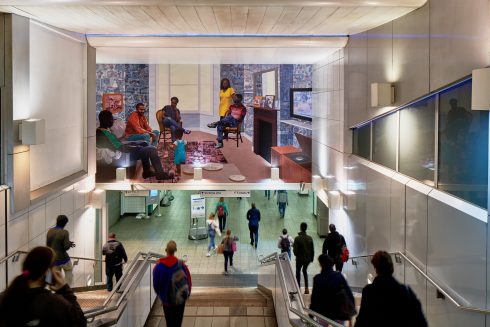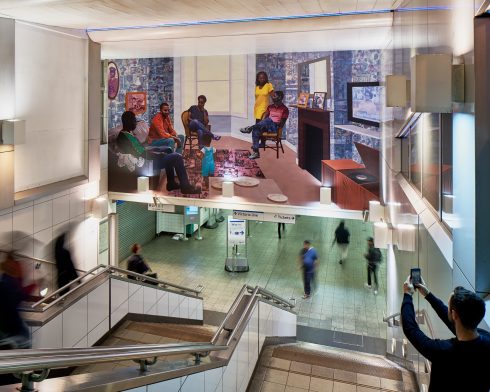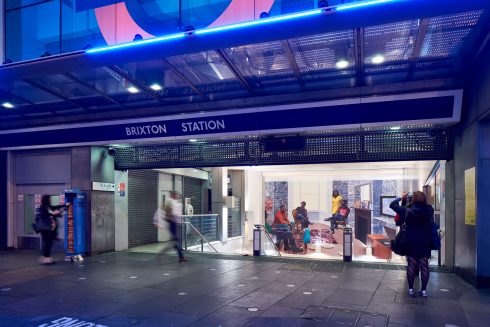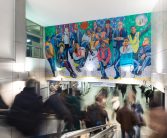Njideka Akunyili Crosby’s commission for Brixton station, Remain, Thriving was on view from September 2018 – April 2019. Nigerian-born Akunyili Crosby was invited to take on the first commission in a new programme at Brixton station. The programme takes the numerous murals that were created in Brixton during the 1980s as an initial point of departure and invites selected artists to respond to their diverse narratives, the rapid development of the area and the wider social and political history of mural making.
Akunyili Crosby’s work explores her hybrid cultural identity, combining strong attachments to the country of her birth and her current home in Los Angeles. This theme continues in her Brixton commission, this time addressing a specifically black British perspective. Akunyili Crosby created a work that investigates shared cultural memory and connects the past and present through an exploration of place. Remain, Thriving was a new work made specifically for the entrance of Brixton Underground station. The work depicts an imagined domestic scene, a theme predominant in much of the artist’s work, of an informal gathering of grandchildren and great grandchildren of the Windrush generation in a fictional home in Brixton. The space contains a number of vestiges of an earlier generation, such as a doily or record player, which the figures might have inherited from their parents or grandparents.
In order to anchor her new work in Brixton, and a British diasporic experience, Akunyili Crosby spent time in the area speaking to longstanding members of the local community as well as public historian Kelly Foster, the Black Cultural Archives, and the Lambeth Archives. The artist collated contemporary and archival images of Brixton to use in her final artwork, and the transferred images in the background of Remain, Thriving echo the heavily patterned wallpaper of a previous era. Through the use of photo-collage, Akunyili Crosby’s layered images of social gatherings are also complex reflections on history, community and politics, much like the original Brixton murals. The artist creates densely layered figurative compositions that, precise in style, conjure the complexity of contemporary experience.
Akunyili Crosby wanted those who travel through the station every day to be able to recognise familiar people and places. Brixton locations such as the shop The Baron and Brixton Recreation Centre are visible, as are iconic people that have lived in Brixton, including the renowned Jamaican-born poet Linton Kwesi Johnson and activist and community leader Olive Morris. Many of the locations featured in the transfers have not survived the recent development of the area, indicating as the Brixton Murals do, how the area has changed in the past few decades.
Akunyili Crosby stated: “For me, this work is for people who grew up in Brixton. I want the past to have a place in the present in this work: the work is very much about the present but the past is so alive in it. I thought a lot about how you engage the space, how you engage people who might already know my work as well as people who have no idea as to why they’re looking at this living room scene as they enter Brixton station. I wanted the piece to be somewhat calming and quiet because it would be located in a bustling station, but I still wanted it to have all of the multi-century layers and stories of Brixton visible. I am honoured to create an artwork for such a public venue and for the opportunity to reach a more diverse audience than I might have before. I think it’s heartening that organisations like Art on the Underground are bringing artwork to public spaces in such a way.”
Alongside the launch of Akunyili Crosby’s work, Art on the Underground produced a new map, extending its existing map series. The Brixton Mural Map is available both online and in print from Brixton tube station and Brixton Library.







